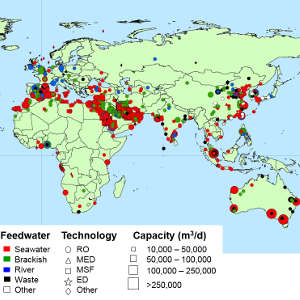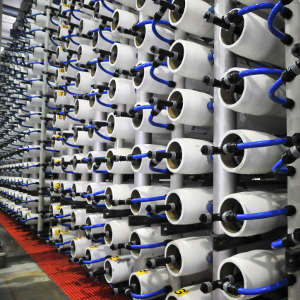Using AI to control energy for indoor agriculture
30 September 2024
Published online 28 January 2019
UN-led research highlights flood of brine discharge from Middle Eastern desalination plants, but some experts claim there’s a bigger picture.

United Nations University, Canada
Enlarge image
Desalination plants convert saltwater into a limitless supply of clean, drinkable water, with the salt discharged as highly saline brine. Since the 1980s, research on desalination technology has grown exponentially, driven by an ever-increasing demand for clean water. “We know that water scarcity is increasing in many regions across the world,” says Manzoor Qadir, assistant director of the Water and Human Development Programme at Canada’s United Nations University, and one of the study’s main authors.
As the technology becomes more efficient and more economically viable, the number of desalination plants grows across the globe. However, despite the large increase in facilities and research, studies into any environmental ramifications have been few. When Qadir and his colleagues assessed the current data on desalination, they found it incomplete and outdated, with no known previous study to quantify brine output at a global scale.
Enough brine to cover Florida
In their paper, published in the journal Science of the Total Environment, Qadir and his colleagues calculated a total of 15,906 currently operating desalination plants across the globe, producing more than 95 million cubic metres of water a day, and more than 141 million cubic metres of brine – enough to cover Florida in over 30cm of discharge every year.
Desalination plants in the Middle East and Northern Africa region produce 48% of the world’s desalinated water, and 70% of its brine discharge, since many facilities in this area use older, less efficient methods such as thermal desalination. Facilities using these methods can produce four times the amount of brine in comparison to more modern, membrane-based desalination plants, say the study’s authors.
As almost 80% of desalinated water is produced within 10km of the coast, the majority of brine waste is discharged directly back into the ocean. The UN-led team are concerned that, over time, this could raise the salt content of the already highly saline seawater, reducing its capacity to hold oxygen and posing a clear risk to marine life. Anti-foulant and processing chemicals present in the discharge could pose an additional risk.
But is it as bad as it seems?

PhotoStock-Israel / Alamy Stock Photo
Riaan van der Merwe, lead author of the 2014 KAUST study and now an assistant professor at Khalifa University in the United Arab Emirates, adds that an often overlooked aspect is the ability of marine life to tolerate increased salinity. Moreover, he says, the brine discharge can actually provide a favourable habitat, having seen locations where “the only life, for literally hundreds and hundreds of metres, is directly around the discharge structure.”
Both researchers agree that this does not mean there are no concerns surrounding desalination. While marine life typically handles salinity quite well, says van der Merwe, there is a risk in the rise in temperature potentially caused by large volumes of warm effluent being dumped into already warming seas. “An increase of as little as 0.5 to 1°C puts enormous stress on some coral species.”
Research efforts are already looking at ways to turn brine from a waste product into a useful commodity. “We’re at a stage now where we need to do more effort to transform brine from an environmental problem into an economic opportunity,” says Qadir. Potential solutions include using the brine in fish farming of salt tolerant species. In one case, the use of brine increased fish biomass by 300%. Other ideas include mining brine to recover the salt and metals it contains. However, while this may be a viable option in the future, the costs currently outweigh the benefits.
Qadir believes that the major brine-producing countries should look to form an alliance. “Here’s an opportunity for countries to learn from each other,” he says, adding that his team is looking forward to collaborating with those countries to assist with brine management and public policy considerations.
doi:10.1038/nmiddleeast.2019.12
Stay connected: